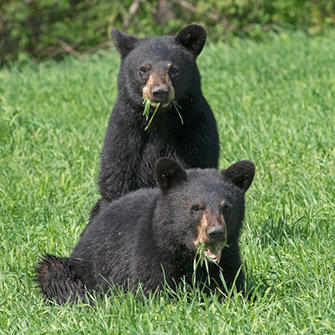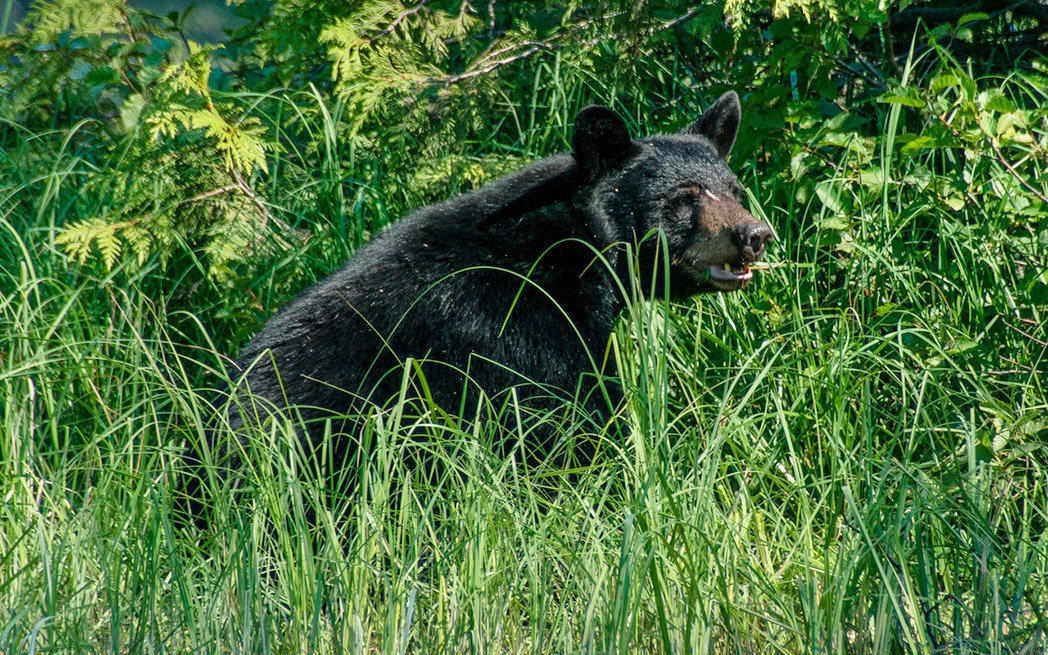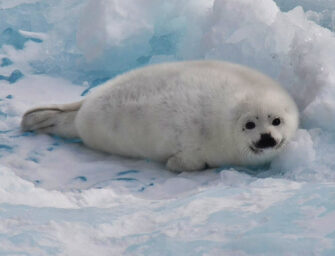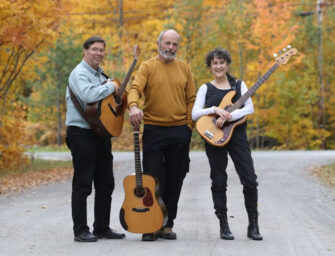A senseless bear killing
in West Island Montreal
The decision to euthanize a young bear was made for the wrong reasons
By Georges R. Dupras
May 29, 2021
The decision made by the Service de la Faune (MNR) to euthanize a young bear that had strayed into Montréal on May 23 was made for the wrong reasons.
Bad decision
First, humans were in no danger as the bear was up a tree, which is a defensive position for a bear. Second, officials had tranquillized the bear, allowing for time to consider other options. Third, a one-and-a-half or two-year-old bear has yet to establish a home range, making it easier to translocate. Fourth, specialists having many years of experience in bear translocation state that, if the bear is taken far enough away from the area of concern, it will not likely return¹.
… humans were in no danger as the bear was up a tree, which is a defensive position for a bear.
Fifth, killing, though at times necessary, is never a solution. It is an admission of failure, and in many cases, due to humankind’s never-ending encroachment on natural habitats. There is also the issue of how killing animals impacts and de-sensitizes children. Lastly, though rarely admitted, the way it affects the average person.
Research – Translocation works²

Two-year-old black bears – Image: courtesy of Mike McIntosh, Bear With Us
“Translocation of nuisance black bears doesn’t affect their survival rate ². I think that it’s important to recognize that translocation can really be an effective management tool”, says Javan Bauder, who conducted his research as a postdoctoral research assistant with the Illinois Natural History Survey. “Just because you translocate nuisance individuals doesn’t mean they are going to have low survival rates”.
Researchers looked back on 38 years of data which included 1,233 marked and translocated nuisance black bears. This data was used to estimate annual mortality rates for both hunted and non-hunted reasons. The review was to estimate bear survival rates for non-translocated individuals that aren’t nuisance bears to act as a control group. The research showed that the “further away” the bears were taken, the higher the survival rate when it came to hunting and non-hunting reasons. “We were surprised at that,” Bauder said.
He figured that moving away from the sources they knew would impact their survivability. When this is not done they become more susceptible to recreational hunting and other human factors. Translocated survival for nuisance bears was lower than that of other bears when their behaviours were affected due to the proximity of their release to human settlements.
‘… specialists having many years of experience in bear translocation state that, if the bear is taken far enough away from the area of concern, it will not likely return.’
“Our study suggests that translocation is an effective way of mitigating human-bear conflict and doesn’t seem to be reducing the survival of the bears.”
One bear specialist³ here in Canada, who has worked in this field for many years, has successfully translocated bears, including older bears. He sees no reason to suggest that a 1.5 to 2-year-old cannot be translocated with the desired results. The trick is to ensure the bear is taken far enough away from the area of concern, and that bear attractants are removed from homes and cottages.
Resources stretched and underfunded
Wildlife services are grossly underfunded and, when you factor in the vast regions each conservation officer (CO) is responsible for, things begin to fall into place.
Beyond an old boys club
It is truly sad that this province, and others, are still catering to special interest groups by practicing political conservation rather than true conservation. That said, officials in each province should recognize that they are here to respond to the needs and concerns of every citizen, regardless of where they live. Wildlife issues would better be served if each province could allocate sufficient funds to allow COs to address issues in a timely manner.
‘With our present loss of species and environmental destruction, it is time to stop sacrificing true conservation in the interest of political gain (rural ridings), budgets and expediency.’
Mandatory and ongoing training for COs is required to minimize injuries and unnecessary killing. This training would include state-of-the-art technologies and a clear understanding of changing social values. Human resources should be chosen with care and those whose backgrounds and mindsets do not lend well to this specialized field should not be chosen.
With our present loss of species and environmental destruction, it is time to stop sacrificing true conservation in the interest of political gain (rural ridings), budgets and expediency.
- See Research paragraph
- Translocation of Nuisance Black Bears. Article by Dana Kobilinsky, Associate Editor for the Wildlife Society
- Mike McIntosh, Bear With Us
Feature image: Enric Cruz López from Pexels
Read also: other articles by Georges R. Dupras

Georges R. Dupras has advocated for animals for over fifty years. A member of the International Association for Bear Research and Management (IBA), a Director of the Animal Alliance of Canada (AAC), Quebec Representative of Zoocheck Canada and past Board member of the Canadian SPCA, he worked on the original Save the Seal campaign in 1966 that culminated in the founding of the International Fund for Animal Welfare (IFAW) in 1969. Georges Dupras has published two books, Values in Conflict and the eBook Ethics, a Human Condition, and currently lives in Montreal, Canada.




































Truly disturbing the way we treat precious wildlife like disposable trash. I agree – things have to change. How about starting a petition in memory of the bear?
Thank you Georges Dupras for an informative discussion on how to deal with nuisance or distressed wildlife. It seems there is plentiful evidence to suggest a more humane and effective answer than what La Faune recommends on a regular basis. Having listened to several recent responses b y La Faune to requests for help, I would suggest that theirs is an antiquated mindset at work rather than a problem of stretched resources.
A woman called La Faune about three orphaned raccoon babies. She was told to leave them in place and that other animals would kill them! Another man called about an injured animal on the roadside. He was told to shoot it! LaFaune called for a cull of deer on the South Shore while others suggested a sterilization program – and who will forget the wildlife officer out west who was fired from him job for wanting to save two small bear cubs.
People’s attitudes about wildlife are evolving. Why is la Faune choosing to remain in the dark ages! There is a great book written by John A. Livingston entitled “The Fallacy of Wildlife Conservation”. It was written in 1980 and unfortunately is completely relevant today.
There is action we can take on this issue. A complaint can be lodged using the following contact information:
Mr. Demosthene Blasi
Responsible for managing complaints
Department of the Deputy Minister’s Office and Secretariat
Ministry of Forests, Wildlife and Parks
5700 4th Avenue West, A 413
Quebec (Quebec) G1H 6 R1
Telephone: 418 ext. 704938
Toll free: 1 855 279-9157
Fax: 418 634-3352
Email: plaintes@mffp.gouv.qc.ca
Also, there is a petition to sign:
https://www.change.org/p/fran%C3%A7ois-legault-premier-ministre-du-qu%C3%A9bec-d%C3%A9mission-du-ministre-de-la-faune-et-for%C3%AAt-pierre-dufour?redirect=false&fbclid=IwAR1BrbapkC3AAVuhRpVX0A67NhDhizYgssuDUNNYZu7NYSQv_vJWeciZ9vI
Let’s let the government know that we do not accept these lethal “solutions” to wildlife issues!
Thank you for sharing this important information Doris!
You’re very welcome Patricia.
Excellent information Doris.
Thank you.
There are times It is apparent that those in power see shooting wildlife is easier and more economical that the saving of an animal’s life.
The wrong animal was dispatched.
And it is an INSULT to use the word Euthanize for what is basically Murder.
Excellent information Doris.
Thank you.
Another young innocent life struck down by the ruthless authorities we depend upon
to do the right thing. George Dupras’ article states categorically all the things that are
wrong with the present approach to “nuisance” animals. This case was made all the
more deplorable since there was a sanctuary available if re-location was not an option.
The killing of the bear was pure murder. There was no excuse for ending it’s life. The bear, a very sentient creature, should have been taken to the Ecomuseum for its own protection. I feared that Montreal’s cops would kill the bear, but it was captured and I breathed a sigh of great belief. The excuses put forward by the ministry that deals with wildlife were extremely flimsy. the authorities did not see the bear as a living creature. Alas, the people who decided to kill the bear will never face justice for their horrid action.
I am 100% for saving, helping and preserving wildlife. But the Service de la Faune should have had a say for the reason of its decision to euthanize the young bear. If the bear was shot by the Service de la Faune when it was up the tree then, the Service de la Faune should be condemned 100% for the killing. The Service made its decision after euthanizing the young bear. Therefore the decision to euthanize it was well thought out and painlessly carried out.
I was present when my dog Doodle was euthanized last year. I had expected a violent reaction for the first and second needles. But there was absolutely no reaction for the two needles. Doodle departed in peace and his departure is a pleasant and peaceful memory for me.
I am 100% against the death penalty. But if an inmate has been proved 100% guilty, why is he or she not be euthanized in the same way as we euthanize dogs? Why the last meal, the twenty years in death row? Why the manhandling to the execution room? Why the presence of a priest, etc. etc. before the execution?
I myself would wish for a departure as peaceful as my dog Doodle’s departure.
Dear Mr. Chin,
In my experience, conservation officers are armed and dispatch wildlife in that manner. It is cheaper to shoot a captive bear than it is to euthanize by means of injection. From what we were told about this incident here in Montreal, the bear had been sedated but was later killed out of sight if the public. You might recall a similar incident in British Columbia, where a Conservation Officer was fired for not shooting a cub. The suggestion that the yearling was somehow put to sleep in the same manner as a family pet does not apply with wildlife. Years ago, when I transported bears to appropriate translocation centers, I was told outright by the MNR in Quebec that those cubs we could not take would be shot.